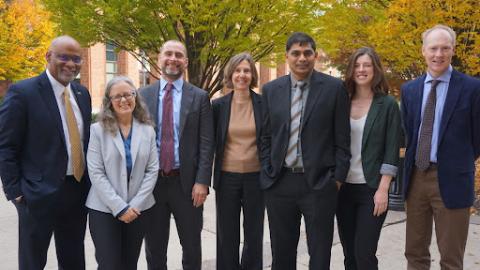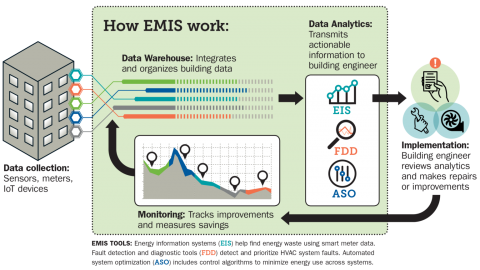Prioritizing Energy Efficiency
The Challenge
If we are going to address rising pollution from greenhouse gas emissions, increasing energy costs, and worldwide growth in energy demand, then the most significant and quickest way to have an impact is through energy efficiency -- in the way we design buildings, appliances, transportation systems, and industrial processes. Even as we move away from fossil fuels and towards cleaner energy sources, it is energy efficiency that will be the key to achieving a more sustainable energy future.
How are we making a difference?
The Energy Technologies Area’s (ETA’s) founder, Art Rosenfeld, is known for pioneering the field of energy-efficiency research. From technologies such as advanced window coatings to building energy simulation tools such as EnergyPlus to analysis that has led to the adoption of dozens of national appliance efficiency standards over the past 25 years, ETA has garnered more than 40 years of energy efficiency expertise. Today, our researchers continue to make significant energy efficiency breakthroughs across the buildings, appliances, and transportation sectors.
ETA researchers work closely with industry, government and policy makers to inform and develop building technology and urban systems that increase energy efficiency, save money and improve health and safety for building occupants.
Our researchers engage in innovative research to advance energy efficiency in the built environment, including in whole building systems, building technology research, and building and industrial applications.
Demand Response
Demand response happens when a utility, aggregator or grid operator induces electricity customers to change their usual power consumption patterns through financial or other incentives. Our research touches on various facets of demand response programs, which can help the grid operate more efficiently, reliably and with more renewable energy systems.
Enabling widespread, effective demand response requires advancements in our understanding of electricity markets, customers, buildings, electric vehicles (EVs) and storage technologies, along with standardized ways for grid operators to communicate with these systems. ETA researchers played a pivotal role in the development of the Open Automated Demand Response Communication Specification, also known as OpenADR, which is an open standards‐based communications data model. OpenADR is designed to promote common information exchange between the utility and electricity consumers using demand response price and reliability signals. ETA’s work in demand response potential modeling led to the concepts of “Shape, Shift, Shed and Shimmy,” moving California to develop more dynamic load flexibility capabilities.
Our researchers also work with utilities, independent system operators (or ISOs), and regional transmission organizations (RTOs) to help electric industry policymakers and stakeholders better understand key elements of demand response rate and program opportunities.
Zero Net Energy
Oakland EcoBlock
In partnership with the local community and UC Berkeley, ETA researchers helped design the Oakland EcoBlock, featuring affordable block-level retrofit strategies for energy efficiency measures, electrification, and distributed energy resources (DERs) via a community scale microgrid.
Oakland EcoBlock is developing the technical, financial, legal, and social strategies to deploy energy and water retrofits at the residential block scale, including energy efficiency, electrification, solar PV, energy storage, EV charging, and microgrids. This program is focused on moderate and lower income communities that would not otherwise be able to afford clean energy technologies, with the overall goal of making their energy more affordable, resilient, and cleaner.
ETA’s researchers provide cutting-edge, comprehensive analyses of the economic and environmental impacts of proposed DOE appliances, equipment, and lighting standards. Appliance standards have proven to be one of the most effective policy tools for reducing energy consumption.
DOE’s Efficiency Standards Program started in 1987, and since then the program has generated more than $1.3 trillion in consumer benefits. Energy savings in 2014 amounted to 4% of U.S. energy consumption.
Energy Efficiency Standards
Analysis and Testing
We conduct analyses and develop testing methods in support of the U.S. Department of Energy’s Appliance and Equipment Standards program. We also conduct techno-economic analyses of more efficient end-use equipment, supporting a variety of research projects.
Global Cooling Efficiency
Energy-Efficient Cooling
Air-conditioning and refrigeration appliance innovation is integral to a sustainable energy future. We conduct global technology and policy-relevant research on the energy efficiency of cooling equipment. Our goal is to develop high-efficiency, low global warming potential refrigerant cooling equipment that is accessible and affordable globally.
Transportation
Transportation of goods and people accounts for about 30% of total U.S. energy needs and 70% of U.S. oil consumption. ETA researchers combine their expertise in simulation and modeling with grid/transportation integration to drive our transportation sector to a more energy-efficient and sustainable future as transportation electrifies. Our research has developed enabling technologies and analysis tools, and applied high-performance computing methods to co-optimize the performance of transportation and electric grid networks.
Energy-Efficient Mobility
Simulation and Modeling
Our researchers develop the data science and computational frameworks needed to build next-generation transportation/mobility system models and operational analytics. Leveraging high-performance computing, sensor data, and big data analytics, they model urban-scale transportation networks and energy systems to optimize mobility, energy efficiency, and productivity.

Research using software developed at Berkeley Lab recently pinpointed actions that could help the historic canal city of Venice, Italy slash energy use and reduce carbon dioxide emissions.

From single-family and multifamily housing to commercial buildings and university campuses, groups of buildings offer untapped potential to boost energy efficiency and reduce greenhouse gas emissions. Through its Connected Communities program, the U.S. Department of Energy (DOE) recently launched nine demonstration projects across the country to explore this potential.

The Smart Energy Analytics Campaign helped drive approximately 4 trillion BTUs of annual energy savings — enough to power more than 44,000 U.S. households for a year — reducing the campaign participants’ collective energy bills by $95 million a year.
